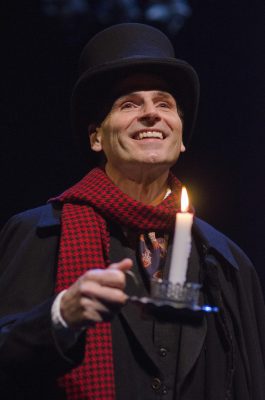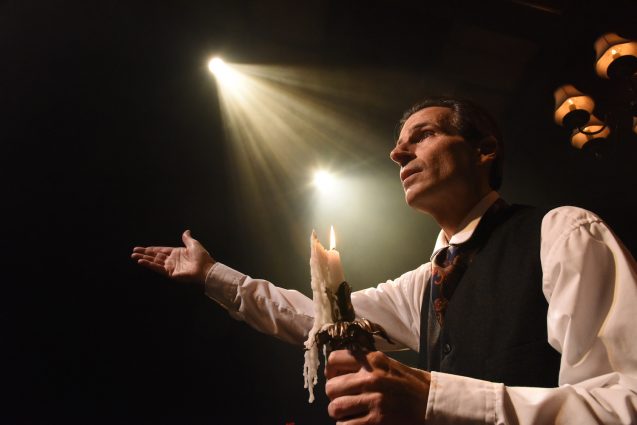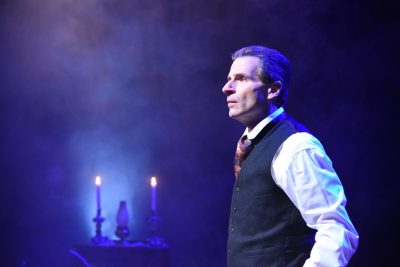Think you’re swamped this holiday season? You should meet Paul Morella.
Of course, if you live in Montgomery County, you probably already have.
That’s because for the last seven years the 61-year-old Bethesda native has made it a point to meet, greet and glad-hand every audience member who walks into (and out of) “Charles Dickens’ A Christmas Carol: A Ghost Story of Christmas.”
It’s kind of high concept for a one-man show; in his adaptation, Morella digs deep into the novella, which has turned into a cultural juggernaut since its publication on Dec. 19, 1843, spawning stage plays, operas, movies and cartoons and fundamentally changing the way the western world celebrates Christmas.

“I don’t want people to think it’s somebody reading a book,” he said, “or somebody running around, putting on different hats and costumes. It’s hard to wrap your mind around it—it’s not a conventional theatrical experience—but once the audience surrenders to it, we’re all in this together.”
And Morella likes it like that. He may play Scrooge every day and sometimes twice a day during the weeks between Thanksgiving and Christmas Eve, but he’s is no miser when it comes to sharing his time with the people who come to see this show. The actor—known for his roles on television (“The Wire”) and movies (“The Pelican Brief”) as well as in countless stage plays here in the D.C. region—sat down to talk about what this ever-evolving holiday tradition means to him, and to dish a little dirt on Dickens and his most famous creation, Ebenezer Scrooge.
You’re not reading the novella; you’re not playing Charles Dickens…how does this one-man-version of “A Christmas Carol” work?
The word Dickensian is kicked around a lot in life, but here it really applies. There are so many Dickensian elements to this show. When I did it first, at the Arts Barn (in Gaithersburg in 2009), there was the idea of actually being Charles Dickens. But then I’d have people come at the door, say, “How’s your mom?” (former representative Connie Morella.) And I thought, I can’t maintain this. It’s not, like, a Williamsburg impersonation. I’m going to be me. A Dickensian version of myself; a Dickensian Everyman.
I guess the best way to describe it, give my “TV Guide” version of what it is, would be “pop-up book come to life.” Marketing this is a challenge: It’s Dickens, it’s dark and it’s a ghost story. But I think you appreciate the light and the radiant aspects of it—the redemption—more because you’ve gone through this ghost story to get there.
You also—literally—go through Paul Morella to get there. What’s up with the meet and greet at the door?
Some things happened serendipitously with the Arts Barn production. Because I was funding it by myself on a limited budget, the set kind of evolved with what I could find in prop storages—here (at Olney) and at Round House. I could only afford one production element, and I thought, sound would probably be more of a trigger to the imagination than, say, lighting. Because I couldn’t hire somebody to do front of house, I ended up greeting people at the door there. That became something that was enjoyable to me and to the patrons, a way to strip away some of the artifice and make it more informal. I still do that.
Being there on the way out—I find that very rewarding. It gives the audience a chance to express what the show meant to them. It means different things to different people: People who have had tragedies in their lives, and this helped them shift direction. There’s a cathartic feeling at the end; it gives people the opportunity to contribute in a way they don’t normally. Usually shows just end.

Is your version of “A Christmas Carol” something families can enjoy together?
Everybody who enters that theater brings their imagination with them, which makes it great for families. The parents can approach the story on its own level, and they can introduce a son or daughter to this world in an enjoyable, non-painful way. If you were compelled to sit down and read something of Dickens, you might not appreciate it as much—but this, unlike a lot of literary adaptations, really lends itself to the stage. Dickens wrote in first person, so the narrator is the guide, and he morphs into the characters, and the language—the words—just to wrap your mouth around them creates the character. These wonderful combinations of the macabre, the sentimental, the funny and the sad–it’s almost Shakespearean in some ways. He’s really done all the work for you. I’d be foolish to alter any of it. It’s there, let the story work its magic.
Is the one-man-show genre a tough one to navigate?
Well, back when (former Olney Theatre artistic director) Jim Petosa, early on, took a gamble on doing it here, he was sort of floored by how it held his attention—that it was compelling throughout. A lot of times, one-person shows become people telling war stories, walking without a net: “Look at me, tackling the actor’s Everest!” But who wants to see that, other than your family—and maybe not even them!
I always ask, “What do you need from these people?” And the answer is, you need a connection. When you don’t have other actors, the audience becomes “it.” There’s an interplay; they don’t have lines, but they definitely contribute, and so the show takes on a different shape, a different aura every time. This, more than anything, becomes a shared experience.
By now do you know the script completely by heart?
Oh, yeah. It’s kind of like archaeology, after all this time. You reach a point where you’re sort of inhabiting the words. There’s a musicality to it, the thought process is done for you and it’s a lot easier to assimilate those lines than, say, a poorly written contemporary play, where your mind is trying to grasp transitions and trajectories. This has a rhythm, a kind of verbal cadence to the language that makes it flow. Just as we retain songs—look, it’s called ‘A Christmas Carol,’ that’s what it is.
How does performing this show affect you physically and mentally?
It’s exhausting, but in an exhilarating way. There are so many contradictions—you’re alert, but you’re spent. It’s like getting on an amusement ride, where sometimes the hardest part is just starting it. Then once it just sweeps you away to the peaks and the valleys, off you go—until you come back to the station, full circle. It’s really kind of breathtaking in a way. The two-show days, yes, they can be very taxing. But it’s really a rush to get to speak this language, to inhabit these characters. People say, “How do you make yourself cry?” and I think, “How could I make myself not cry?” You fall in love with the characters over the course of the evening, go through the journey, live with the people. The waves hit.

Do you have a favorite?
Character? I really don’t—I relish them all, and I’m looking to make every character that’s in the show count. It’s so complex—I mean, what kind of a Christmas story begins with a line like, “Marley was dead”? You don’t get to “once upon a time” until you’re past the introduction to this Lear-like character, Scrooge, so it kind of sets you up that this is not going to be a conventional Christmas story. You’re going to have to go through the darkness to get to the light.
Do you see people coming year after year?
I do. They say, “This is our yearly pilgrimage; this is how we start our Christmas season.” So, I don’t want to tinker to the point where it alters what’s there, but there’s a sort of reimagining each year. We have a sort of shorthand now; we can make it more immersive every year—make it bigger by making it smaller. The idea is to give the audience enough information to let their imagination take it the rest of the way. A lot of theaters look at “A Christmas Carol” as their cash cow for this time of year. They pull it out of the box, throw some water on it and put it in front of an audience. I don’t want to do that. I wouldn’t enjoy that, and I don’t think anyone else would, either.
Feelings are so intensified at this time of year. There are people who look at the holiday landscape, say “We’re going to ‘A Christmas Carol’ this year, it’s a ritual—which one are we gonna do?” The goal is to give them an experience unlike any “Christmas Carol” they’ve ever seen before…the irony being, it’s the real deal. You are entering the world of the book.
Why are you telling this story?
It’s to let people know—to show them—that we have to make the most of what we have, and with each other. Fred, Scrooge’s nephew, has this wonderful line about how this time of year is “…the only time I know of, in the long calendar of the year, when men and women seem by one consent to open their shut-up hearts freely, and to think of people below them as if they really were fellow-travelers to the grave, and not another race of creatures bound on other journeys.”
That’s dark, but it’s not. We really are fellow travelers.
Olney Theatre Center, 2001 Olney-Sandy Spring Road, presents “Charles Dickens’ A Christmas Carol: A Ghost Story of Christmas,” a solo performance by Paul Morella in the Mulitz-Gudelsky Theatre Lab through Dec. 31. Tickets start at $20 and can be purchased by calling 301-924-3400 or visiting olneytheatre.org. View this event on CultureSpotMC here.